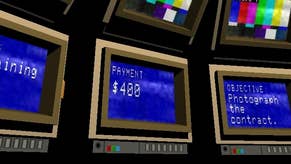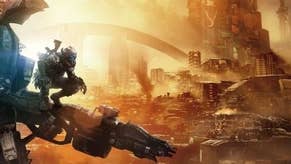Quadrilateral Cowboy review
A fistful of $variable$.
In Quadrilateral Cowboy, a surreal indie game of hacking and heists, you pull out your 'deck' - a briefcase-sized, late-80s/early-90s portable computer with a fold-out screen and a DOS prompt - and type on it to hack systems and command gizmos. Only, you're not really doing this. You're actually gazing into the virtual reality goggles of another chunky bit of retro computing in your hackers' lair, surrounded by flickering CRTs, humming mainframes and whirring tape decks, planning some future heist in the 'real' world. Only, you're not really doing that either. You're typing on your own keyboard in your own room, playing Quadrilateral Cowboy. (I recommend using a mechanical keyboard for the full, clattering, War Games wish-fulfilment.) Wheels within wheels!
This is about as post-modern as video games get, from its self-referential premise, to its hipster fetishisation of retro technologies, to its scruffy, anti-chic aesthetic. Quadrilateral Cowboy is a game with purposefully ugly levels decorated in placeholder art, where patch notes float in the air and you can turn on 'noclip' mode to glitch through the scenery. It's a game soundtracked by warbling acetate 78s playing on your 'vinylman' portable record player.
It could be grating, but developer Blendo Games - which is mostly a man called Brendon Chung - has a way with this kind of material. Surreal and slyly humorous, Blendo's games delight in the unexpected, and shake up a unique cocktail of crude presentation, oddball pulp, and deceptively sophisticated, elliptical storytelling. All are on show in Chung's masterpiece, the micro-epic Thirty Flights of Loving, a narrative game that packs more into its 15 minutes than most manage in two dozen hours. (And what a title! As a writer, Chung has a talent for poetic non-sequitur; one level in Quadrilateral Cowboy is called The Finger Lime Funicular.)
So I was totally up for Quadrilateral Cowboy's weird world: a sort of quaint, steampunk-cum-cyberpunk playground where the hover bikes have two-stroke engines, virtual worlds come on cassette, and security codes are delivered by pneumatic tube. In between missions, it recalls the best of Thirty Flights and its predecessor Gravity Bone with little playable tableaux, packed with interactive detail, that suggest but never spell out multi-faceted backstories for your little hacking crew.
But Quadrilateral Cowboy is much more of a game, and just much more game, than those wonderful miniatures. By Blendo's standards it's a monster - several whole hours long! - and it swaps trippy, jump-cut storytelling intensity for a puzzle-solving design built around a series of gadgets and the simple programming language of your deck. The toys are cool: you get a tiny brass robot quadruped you can program to explore small spaces (like a Big Trak), a remote suitcase rifle, a jump pad.
And it's fun to see a game engage head-on with programming, the very stuff of its making, and exploit it as a game mechanic. You won't need any coding skill; the command syntax is very simple to grasp. The challenge is in solving the puzzle of each location, with its network of doors and gates and vaults and lasers and timed alarms (if anything stays open for longer than 3 seconds, you're in trouble), by positioning your gadgets and writing a script for them that will enable you to to get in and out with what you came for in the blink of an eye.

Wonderful wish-fulfilment, then, but it sounds more fun than it is. Execution tends to be a case of tricksy trial-and-error that isn't rewarding in itself. It feels cool to type out the command, but not so much to debug and test it, reloading the level to try out new orders and values. The tools you're given beg for a sandbox, but that's not what these levels are - unlike in, say, Tom Francis' Gunpoint, you're very much having to reverse-engineer your way to the single solution that's written into them from the start. Nor do those solutions have the imaginative force that makes brain-teasers like Portal or The Witness such a pleasure to unknot.
Chung's restless, scattershot energy, which energises his storytelling, doesn't serve him so well as a designer. He doesn't seem that interested in exploring his ideas in depth. New gadgets come thick and fast, but are quickly discarded in favour of the next, and they feel underutilised. Economy in narrative is a great thing, but I felt like I wanted longer with each of Quadrilateral Cowboy's moving parts for them to bed in, for me to feel I had mastered them, and for the game's level design to really test their abilities and my imagination. What you end up is a game that is much bigger in scope than its author's previous work, but that perversely feels like more of a sketch.













